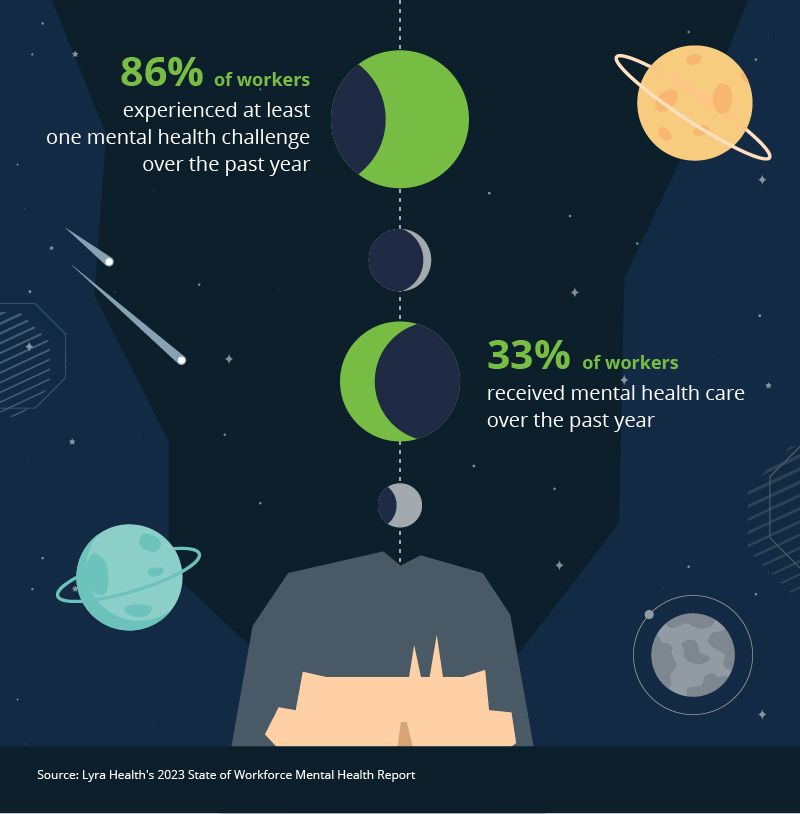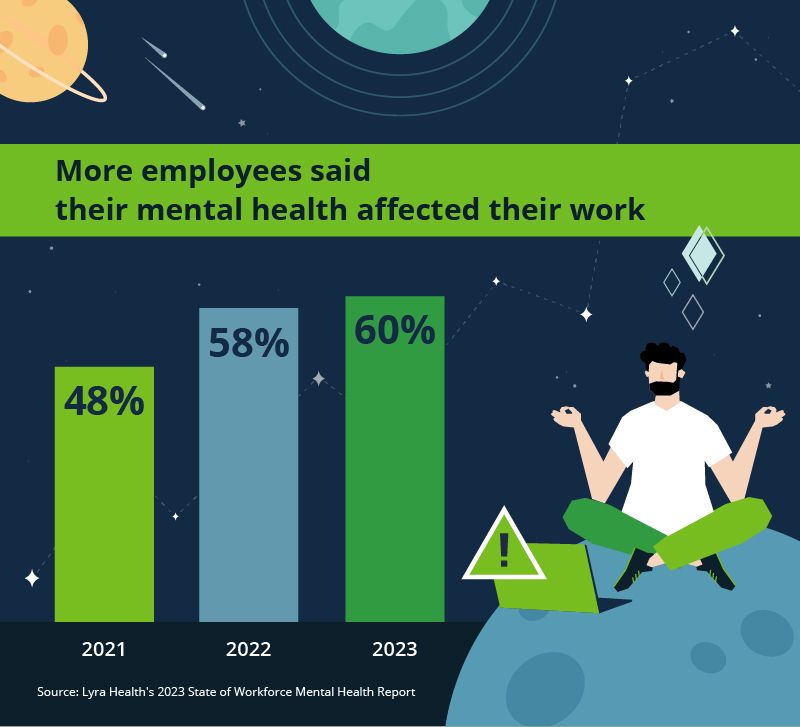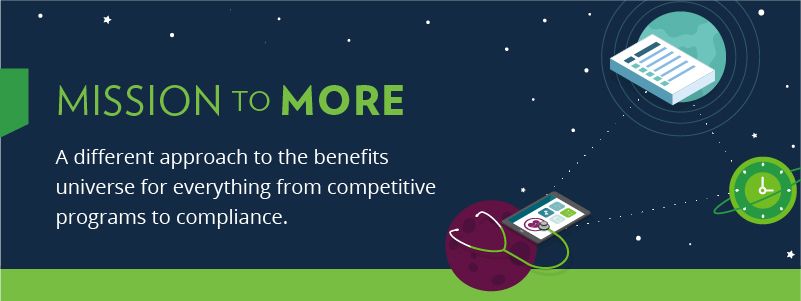Blog
What to Consider When Choosing a Mental Health Solution for Your Employee Benefits Program
This article walks you through some surprising statistics on mental health in the workplace and what to consider when choosing a mental health benefits solution.
Untreated mental health challenges can have a direct impact on how well employees perform at work—and the number of employees affected is rising. In 2021, 48% of employees said their mental health affected their work. That number rose to 60% in 2023.
The desire for mental health care has persisted post-pandemic, but access is often insufficient, whether due to a lack of employer benefits or long wait times to see a provider. Because of this, ease of access to mental health benefits can impact employee well-being, engagement, and retention.
| At-a-Glance Read time: 5 minutes |
||
|---|---|---|
According to Lyra Health's 2023 State of Workforce Mental Health report, 86% of workers experienced at least one mental health challenge over the past year, but only 33% of workers received mental health care during that same time frame. These numbers are even more concerning considering that 55% of counties in the continental US have no psychiatrists, and 77% have a severe shortage, according to Steinberg Institute.

While employers may be concerned about challenging economic conditions eating into their bottom line, investing in mental health benefits is critical for business. Mental health point solutions can help address workplace stress and keep employees engaged, healthy, and happy at work. Plus, as more workers expect mental health benefits from their employers, offering a program can help attract and retain talent.
This increased interest in addressing mental health has resulted in a wide range of benefits offerings. While this provides more opportunities for employers to support their employees, it can lead to more questions about the best fit for your organization. We’ll review questions to help you choose the right solution for your organization.

Questions to Ask When Choosing a Mental Health Benefit Solution
Whether you end up offering crisis support, group therapy, or other types of mental health benefits, choosing a vendor comes down to determining employee needs and what the plans offer. In addition to reviewing the services offered, a best practice should also include a demo of the platform to ensure a cultural fit with your organization. Answering the questions below can assist in finding the right solution for your company.
What key services resonate with your employee base?
Do workers in your industry experience higher rates of suicide or addiction? Or do your employees encounter high-stress job environments? Employees in these situations may benefit from crisis support or group therapy. In 2021, according to Future Forum, 38% of workers globally reported being burned out; two years later, that number rose to 42%. Two groups are at the greatest risk of burnout: women and workers under the age of 30. 48% of 18- to 29-year-olds reported feeling drained compared with 40% of respondents aged 30 and up. Women (46%) reported higher levels of burnout than men (37%). One-on-one support of therapist coaching and psychiatry may be good options for these demographics.
How many visits will the plan provide?
Most mental health benefits vendors offer up to 12 sessions per year, though some may offer unlimited sessions.
What is the cost per employee per month (PEPM)?
The cost of mental health benefits typically falls between $3–$9 PEPM. Companies can pay this on a prepaid and/or utilization model. Typical employee assistance programs (EAPs) can be on the lower end of the spectrum. Technology-based platforms that include in-person, phone, and chat sessions can fall on the higher end of the cost spectrum.
What will the plan cost each year?
Estimated annual fees will vary based on the number of employees. You will also want to figure in implementation fees. The estimated annual fee will be different depending on whether rates are prepaid or based on utilization. The cost will vary based on the types of programs offered on the platform. Some platforms offer additional employer support, including HR training programs and diversity, equity, and inclusion programs.
What else do I need to consider?
Additional questions you may ask about a plan include:
- Does it require a contract for a specified amount of time?
- Does the plan have providers as part of its own network? Does it offer psychiatry sessions at an additional cost?
- Can the plan be purchased as a stand-alone? Or can it be included as a service to augment a more traditional EAP with a wider range of services?
- Do you need a vendor with a national network?
- Does the solution cater to key demographics, like women versus men, or specific mental needs, like substance use disorder? Does the solution have specific programs that support LGBTQ+ or other historically marginalized communities?
Choosing a Mental Health Benefit Can Be Easy
Mental health benefits are good for both employees and employers. The need for mental health benefits isn’t going away; in fact, the scope of benefits is growing. While employers have a wide variety of mental health benefits vendors to choose from, making that choice doesn’t have to be difficult. Ongoing education and a close understanding of your employee base will help you make an informed decision, and having the right broker by your side can make it easy to find the right solution.
Our Mission to More series offers guidance from leading specialists on what employees want and how employers can adapt to the new benefits universe. For more guidance on trends and emerging benefits solutions, sign up for Woodruff Sawyer’s Benefits newsletter, which includes all Mission to More articles.
Table of Contents










